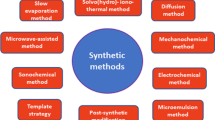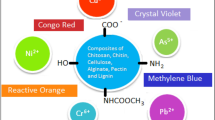Abstract
Chlorophenols, common organic pollutants, released from the various industrial processes are toxic and persistent in nature, bearing acute and chronic effects on human health. Herein, we report the synthesis of a novel triazine-based resin for the adsorptive removal of chlorophenols (CPs), namely chlorophenol (CP), dichlorophenol (DCP), and trichlorophenol (TCP). The resin, dubbed as MAICY, was synthesized in a straightforward fashion in a single step from the condensation of commercially available melamine and tris(2,3-epoxypropyl) isocyanurate. MAICY was characterized by diverse techniques including FESEM, FT-IR, solid (CP-MAS) 13C-NMR, and TGA. Various adsorption parameters such as the effect of pH of the solution, adsorbent dosage, CPs concentration, and adsorption temperature were thoroughly studied and optimized. Compared to other CPs, the adsorption capacity (qe) of TCP (76 mg g−1) at pH = 7 was found to be the highest, attaining a rapid adsorption equilibrium within 10 min. The kinetics data for adsorption of CPs were well fitted by pseudo-second-order rate equation with the value of R2 = 0.9863–0.9983, close to 1.000. Within the applied adsorption isotherms, the Freundlich model was observed to be the best fit for the adsorption of CPs (R2 = 0.9734–0.9947). Moreover, MAICY exhibited very good reusability and recyclability in synthetic wastewater (SWW) samples up to five consecutive cycles of adsorption–desorption for CP, DCP, and TCP removal.
Graphical abstract













Similar content being viewed by others
Data availability
The related experimental data are presented in the manuscript.
References
Garba ZN, Zhou W, Lawan I et al (2019) An overview of chlorophenols as contaminants and their removal from wastewater by adsorption: a review. J Environ Manage 241:59–75. https://doi.org/10.1016/J.JENVMAN.2019.04.004
Issabayeva G, Hang SY, Wong MC, Aroua MK (2018) A review on the adsorption of phenols from wastewater onto diverse groups of adsorbents. Rev Chem Eng 34:855–873. https://doi.org/10.1515/REVCE-2017-0007
Czaplicka M (2004) Sources and transformations of chlorophenols in the natural environment. Sci Total Environ 322:21–39. https://doi.org/10.1016/J.SCITOTENV.2003.09.015
Ahmaruzzaman M (2008) Adsorption of phenolic compounds on low-cost adsorbents: a review. Adv Colloid Interface Sci 143:48–67. https://doi.org/10.1016/J.CIS.2008.07.002
Słomkiewicz P, Szczepanik B, Czaplicka M (2020) Adsorption of phenol and chlorophenols by HDTMA modified halloysite nanotubes. Materials 13:3309. https://doi.org/10.3390/MA13153309
Ahmed Adam OEA, Al-Dujaili AH (2013) The removal of phenol and its derivatives from aqueous solutions by adsorption on petroleum asphaltene. J Chem. https://doi.org/10.1155/2013/694029
Das S, Banthia AK, Adhikari B (2008) Porous polyurethane urea membranes for pervaporation separation of phenol and chlorophenols from water. Chem Eng J 138:215–223. https://doi.org/10.1016/J.CEJ.2007.06.030
Bel Hadjltaief H, Sdiri A, Ltaief W et al (2018) Efficient removal of cadmium and 2-chlorophenol in aqueous systems by natural clay: Adsorption and photo-Fenton degradation processes. Comptes Rendus Chim 21:253–262. https://doi.org/10.1016/J.CRCI.2017.01.009
Yoon J-H, Shim Y-B, Lee B-S et al (2012) Electrochemical degradation of phenol and 2-chlorophenol using Pt/Ti and boron-doped diamond electrodes. Bull Korean Chem Soc. https://doi.org/10.5012/bkcs.2012.33.7.2274
Achak M, Elayadi F, Boumya W (2019) Chemical coagulation/flocculation processes for removal of phenolic compounds from olive mill wastewater: a comprehensive review. Am J Appl Sci 16:59–91. https://doi.org/10.3844/AJASSP.2019.59.91
González-García J, Sáez V, Tudela I et al (2010) Sonochemical treatment of water polluted by chlorinated organocompounds. A Review Water 2:28–74. https://doi.org/10.3390/W2010028
Mohammad AT, Al-Obaidi MA, Hameed EM et al (2020) Modelling the chlorophenol removal from wastewater via reverse osmosis process using a multilayer artificial neural network with genetic algorithm. J Water Process Eng 33:100993. https://doi.org/10.1016/J.JWPE.2019.100993
Uçar M (2019) Adsorption of chlorophenolic compounds on activated clinoptilolite. Adsorpt Sci Technol 37:664–679. https://doi.org/10.1177/0263617419870671
Mansha M, Waheed A, Ahmad T et al (2020) Synthesis of a novel polysuccinimide based resin for the ultrahigh removal of anionic azo dyes from aqueous solution. Environ Res 184:109337. https://doi.org/10.1016/j.envres.2020.109337
Garba ZN, Zhou W et al (2019) An overview of chlorophenols as contaminants and their removal from wastewater by adsorption: a review. J Environ Manag 241:59–75. https://doi.org/10.1016/J.JENVMAN.2019.04.004
Zhang L, Sun J, Qi Y et al (2020) Forming nanoconjugates or inducing macroaggregates, curcumin dose effect on myosin assembling revealed by molecular dynamics simulation. Colloids Surfaces A Physicochem Eng Asp 607:125415. https://doi.org/10.1016/J.COLSURFA.2020.125415
Allaboun H, Al-Rub FAA (2016) Removal of 4-chlorophenol from contaminated water using activated carbon from dried date pits: equilibrium, kinetics, and thermodynamics analyses. Materials. https://doi.org/10.3390/MA9040251
Qaid FA, Azzahari AD, Yahaya AH, Yahya RB (2015) Adsorption of 4-chlorophenol from wastewater-based activated carbon prepared from Jatropha seed husks. Desalin Water Treat 57:294–302. https://doi.org/10.1080/19443994.2015.1035497
Fan H-T, Zhao C-Y, Liu S, Shen H (2017) Adsorption Characteristics of Chlorophenols from Aqueous Solution onto Graphene. J Chem Eng Data 62:1099–1105. https://doi.org/10.1021/ACS.JCED.6B00918
Caetano M, Valderrama C, Farran A, Cortina JL (2009) Phenol removal from aqueous solution by adsorption and ion exchange mechanisms onto polymeric resins. J Colloid Interface Sci 338:402–409. https://doi.org/10.1016/J.JCIS.2009.06.062
Farrier DS, Hines AL, Wang SW (1979) Adsorption of phenol and benzoic acid from dilute aqueous solution onto a macroreticular resin. J Colloid Interface Sci 69:233–237. https://doi.org/10.1016/0021-9797(79)90152-8
Kawabata N, Yoshida J, Tanigawa Y (1981) Removal and recovery of organic pollutants from aquatic environment. 4. Separation of carboxylic acids from aqueous solution using crosslinked poly(4-vinylpyridine). Ind Eng Chem Prod Res Dev 20:386–390. https://doi.org/10.1021/i300002a030
Ku Y, Lee K-C (2000) Removal of phenols from aqueous solution by XAD-4 resin. J Hazard Mater 80:59–68. https://doi.org/10.1016/S0304-3894(00)00275-2
Wang J-p, Fei Z-h (2006) Adsorption characteristics of chlorophenols from aquatic systems by hypercrosslinked resins modified with benzoyl group. Chinese J Polym Sci 24:545–551. https://doi.org/10.1142/S025676790600162X
Fei Z (2007) Adsorption of 2,4-dichlorophenol in aqueous solution onto adsorption resin modified by n-acetylaniline. Chinese J Polym Sci 25:263. https://doi.org/10.1142/S0256767907002096
Waheed A, Kazi IW, Manzar MS et al (2020) Ultrahigh and efficient removal of Methyl orange, Eriochrom Black T and acid Blue 92 by triazine based cross-linked polyamine resin: synthesis, isotherm and kinetic studies. Colloids Surfaces A Physicochem Eng Asp 607:125472. https://doi.org/10.1016/j.colsurfa.2020.125472
Soto ML, Moure A, Domínguez H, Parajó JC (2011) Recovery, concentration and purification of phenolic compounds by adsorption: a review. J Food Eng 105:1–27. https://doi.org/10.1016/J.JFOODENG.2011.02.010
Wang WQ, Wang JC, Fan JG, Liu XS, Liu ZT, Jiang ZW, Jinqiang Hao Z (2015) Synthesis of novel hyper-cross-linked polymers as adsorbent for removing organic pollutants from humid streams. Chem Eng J 281:34–41. https://doi.org/10.1016/J.CEJ.2015.06.095
Hu A, Liqing L, Zhang M et al (2021) Synthesis of highly water-dispersible adsorbent derived from alkali-modified hyper-cross-linked polymer for efficient removal of various organic contaminants and ammonia. J Water Process Eng 40:101902. https://doi.org/10.1016/J.JWPE.2020.101902
Manzar MS, Waheed A, Qazi IW et al (2019) Synthesis of a novel epibromohydrin modified crosslinked polyamine resin for highly efficient removal of methyl orange and eriochrome black T. J Taiwan Inst Chem Eng 97:424–432. https://doi.org/10.1016/j.jtice.2019.01.027
Waheed A, Mansha M, Kazi IW, Ullah N (2019) Synthesis of a novel 3,5-diacrylamidobenzoic acid based hyper-cross-linked resin for the efficient adsorption of Congo Red and Rhodamine B. J Hazard Mater 369:528–538. https://doi.org/10.1016/j.jhazmat.2019.02.058
Zhu H, Xu S (2018) Preparation and fire behavior of rigid polyurethane foams synthesized from modified urea–melamine–formaldehyde resins. RSC Adv 8:17879–17887. https://doi.org/10.1039/C8RA01846D
Mansha M, Kazi IW, Manzar MS et al (2020) Ultrahigh removal of methyl orange, acid blue-92 and malachite green by a novel triazine-based polyamine resin: synthesis, isotherm and kinetic studies. Int J Environ Anal Chem. https://doi.org/10.1080/03067319.2020.1858072
Foo KY, Hameed BH (2010) Insights into the modeling of adsorption isotherm systems. Chem Eng J 156:2–10. https://doi.org/10.1016/J.CEJ.2009.09.013
Langmuir I (1918) The adsorption of gases on plane surfaces of glass, mica and platinum. J Am Chem Soc 40:1361–1403. https://doi.org/10.1021/JA02242A004
Kundu S, Gupta AK (2006) Arsenic adsorption onto iron oxide-coated cement (IOCC): Regression analysis of equilibrium data with several isotherm models and their optimization. Chem Eng J 122:93–106. https://doi.org/10.1016/J.CEJ.2006.06.002
Weber TW, Chakravorti RK (1974) Pore and solid diffusion models for fixed-bed adsorbers. AIChE J 20:228–238. https://doi.org/10.1002/AIC.690200204
Adejo SO, Ekwenchi MM, Gbertyo JA et al (2014) Determination of Adsorption Isotherm model best fit for methanol leaf extract of Securinega virosa as corrosion inhibitor for corrosion of mild steel in HCl. J Adv Chem 10:2737–2742. https://doi.org/10.24297/JAC.V10I5.891
Li H, Fu Z, Yan C et al (2016) Hydrophobic-hydrophilic post-cross-linked polystyrene/poly (methyl acryloyl diethylenetriamine) interpenetrating polymer networks and its adsorption properties. J Colloid Interface Sci 463:61–68. https://doi.org/10.1016/j.jcis.2015.10.044
Lima EC, Hosseini-Bandegharaei A, Moreno-Piraján JC, Anastopoulos I (2019) A critical review of the estimation of the thermodynamic parameters on adsorption equilibria. Wrong use of equilibrium constant in the Van’t Hoof equation for calculation of thermodynamic parameters of adsorption. J Mol Liq 273:425–434. https://doi.org/10.1016/j.molliq.2018.10.048
Thue PS, Sophia AC, Lima EC et al (2018) Synthesis and characterization of a novel organic-inorganic hybrid clay adsorbent for the removal of acid red 1 and acid green 25 from aqueous solutions. J Clean Prod 171:30–44. https://doi.org/10.1016/j.jclepro.2017.09.278
Lima ÉC, Adebayo MA, Machado FM (2015) Kinetic and equilibrium models of adsorption. Carbon nanostructures. Springer International Publishing, New York, pp 33–69
Alkaram UF, Mukhlis AA, Al-Dujaili AH (2009) The removal of phenol from aqueous solutions by adsorption using surfactant-modified bentonite and kaolinite. J Hazard Mater 169:324–332. https://doi.org/10.1016/j.jhazmat.2009.03.153
Gao R, Wang J (2007) Effects of pH and temperature on isotherm parameters of chlorophenols biosorption to anaerobic granular sludge. J Hazard Mater 145:398–403. https://doi.org/10.1016/J.JHAZMAT.2006.11.036
Jain AK, Gupta VK, Shubhi Jain A, Suhas (2004) Removal of Chlorophenols Using Industrial Wastes. Environ Sci Technol 38:1195–1200. https://doi.org/10.1021/ES034412U
Tubić A, Lončarski M, Maletić S et al (2019) Significance of chlorinated phenols adsorption on plastics and bioplastics during water treatment. Water. https://doi.org/10.3390/w11112358
Sathishkumar M, Binupriya AR, Kavitha D, Yun SE (2007) Kinetic and isothermal studies on liquid-phase adsorption of 2,4-dichlorophenol by palm pith carbon. Bioresour Technol 98:866–873. https://doi.org/10.1016/J.BIORTECH.2006.03.002
Acknowledgements
The authors would like to acknowledge and sincerely thank the Center for Environment and Marine Studies (CEMS) at King Fahd University of Petroleum and Minerals (KFUPM) for its support and funding of this research study.
Author information
Authors and Affiliations
Corresponding authors
Ethics declarations
Conflict of interest
The authors declare that there is no conflict of interest regarding the publication of this manuscript.
Additional information
Publisher's Note
Springer Nature remains neutral with regard to jurisdictional claims in published maps and institutional affiliations.
Supplementary Information
Below is the link to the electronic supplementary material.
Rights and permissions
Springer Nature or its licensor (e.g. a society or other partner) holds exclusive rights to this article under a publishing agreement with the author(s) or other rightsholder(s); author self-archiving of the accepted manuscript version of this article is solely governed by the terms of such publishing agreement and applicable law.
About this article
Cite this article
Mansha, M., Ilyas, M., Rao, D. et al. Synthesis of melamine-isocyanurate-based hyper-cross-linked resin for ultrahigh removal of chlorophenols from aqueous solutions. Polym. Bull. 80, 10051–10071 (2023). https://doi.org/10.1007/s00289-022-04543-1
Received:
Revised:
Accepted:
Published:
Issue Date:
DOI: https://doi.org/10.1007/s00289-022-04543-1




